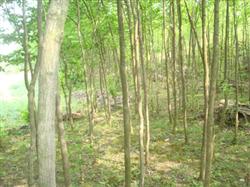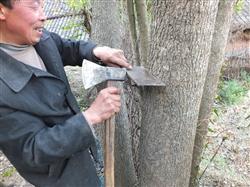How to raise seedlings and plant Eucommia ulmoides?

How do you plant and grow trees? Please give an introduction There are many propagation methods of Euonymus ulmoides, such as seeding, cuttings, residual root culture and seedling root culture. (1)sowing and seedling First select good seeds, then sow seedlings. Seeds are collected from about 20-year-old mature trees with strong growth, smooth bark, no diseases and insect pests and without peeling. About 7000~20000 seeds per kilogram, the germination rate is generally 60%~80%. The collected seeds are dried in a ventilated and cool place. It is forbidden to dry them with fire or sun exposure. The seeds dried in the shade can be stored after cleaning. Seeds can be stored in sand germination method or water immersion germination method for germination treatment. The seeds can be sown in late autumn, November or early spring, mainly in drilling, row spacing 25~30cm, sowing 40~50 seeds per meter in the sowing ditch, sowing seeds evenly in the ditch, covering soil 1.5~ 2 cm, sowing rate 5~10kg per mu, seeds stored in sand can be unearthed 15 days after sowing, while dry seeds soaked in germination need 25~30 days, and the seedling yield per mu is about 20 ~ 30,000. (2)cuttings The shoots sprouted in spring of that year with tender leaves were cut into cuttings of 5~6 cm long, and 3 axillary buds were reserved for each cutting. In order to reduce water evaporation, half of each leaf should be cut off and cut in May. The upper layer of cutting ground is sandy soil, 2~3cm thick, the lower layer keeps loose soil, cuttings are buried 1.5~2cm, plant spacing is 4~ 8cm, watering and shading must be paid attention to after cutting. Callus can be produced after 6~7 days, and small roots can be produced after 18~30 days. (3)residual root culture method This method is to dig out about 3/5 of all roots of seedlings in spring, so that 2/5 of the roots are still left in the soil, after the seedlings are finished, a layer of topsoil on the seedbed is taken out, so that one end of the broken roots is slightly exposed to the soil surface, and new seedlings are sprouted. (4)seedling root method The use of thick roots pruned from seedlings, generally using more than 0.5 cm, cut into 5~6 cm long root segments for cuttage, survival rate can reach more than 95%. In addition, the roots of young trees can also be dug for cuttage, the survival rate is also high, and the seedlings grow strong. (5)seedling management During the seedling stage of Euonymus ulmoides, management must be strengthened, and intertillage, weeding, fertilization, irrigation and drainage should be done in time. When the seedlings just emerged, it is only appropriate to pull out weeds by hand to avoid damaging the seedlings. When the seedlings grow 3~4 true leaves, except for the second grass, weeding 1~2 times a month before August, often keep the nursery free of grass and loose soil. April to August is the top dressing period of seedlings. It is better to apply fertilizer in small amount and many times. With the growth of seedlings, the amount of fertilizer is increased. Urea is applied 5~10 kg per mu. Fertilization and intertillage weeding are carried out simultaneously. In terms of irrigation, irrigation should be frequent in areas with little rain and dry seasons to keep the soil moist, and drainage ditches should be set up in rainy areas and flood seasons to avoid soil ponding. 2. cultivation techniques Eulex ulmoides is a positive tree species, which is most suitable for growing in the soil with deep, fertile and moist soil, good drainage and pH between 6 and 7.5. It grows well at the foot of the mountain, on the mountainside and on the sunny slope with small slope. It is better to add shade at the seedling stage. The mountainside or the middle and lower part of the mountainside on the south slope or southeast slope should be selected when constructing Euonymus ulmoides forest. In addition to large areas of Euonymus ulmoides forest, but also to make full use of the four sides and field ridge planting. These places have sufficient light and good soil water and fertilizer conditions, which are convenient for management and conducive to the growth and development of Eulex ulmoides. (1)site preparation The soil preparation should be carried out in autumn. Mountain refining should be carried out on barren and semi-barren mountain areas suitable for forestry. When the slope is above 100, terraced soil preparation must be carried out, the hole size for afforestation is 70 × 70× 70cm, 10 kg of soil miscellaneous fertilizer, 0.5 kg of phosphorus fertilizer and 0.5 kg of decomposed cake fertilizer are applied to each hole, and afforestation is not suitable when the slope is above 250. (2)afforestation techniques Euonymus ulmoides plantation can be carried out in spring and autumn, cold areas should be carried out in spring. Afforestation density mainly depends on the operation mode and site conditions. Generally, afforestation density is 1.5×2m, 2×2m and 2×3m. In order to ensure the sexual reproduction of Eulex ulmoides, the proportion of male plants in afforestation is 5%~10%. Autumn planting in September to October, spring planting in March to April. After planting, we should irrigate immediately and pick off the lateral buds in time to promote their survival. Leguminous crops can be intercropped during the young forest period, which not only increases income, but also improves soil and promotes tree growth. 3. tending management It is very important to manage Eulex ulmoides young stands. After one year of afforestation, the trunk of young trees in spring should be cut off 15 days before germination. The 2-year nursery stubble seedlings or grafted seedlings with a height of more than 2m at the stubble position 2~4 cm will not be stubble after planting. After stubble cutting, many sprouts will sprout at the cut mouth, leaving a thick sprout and removing the rest; the axillary buds will sprout during the growth process of the remaining sprouts, and the lower axillary buds must be removed. The height of the bud is 1/3~1/2 of the seedling height. Young trees fail to wipe buds in time and grow into too many, too low lateral branches, trunk 2m below the small lateral branches must be cut off from the base. To strengthen soil and fertilizer management, the first loosening should be carried out before early April, and the second loosening and weeding should be carried out in early May or June. Weeds should be turned over to the forest land or made into compost, decomposed and applied. Fertilization, loosening and weeding are carried out simultaneously, and 10kg nitrogen fertilizer and 20kg phosphorus fertilizer are applied per mu. The young forest needs to be intercropped with leguminous crops to replace cultivation. The second year after afforestation, the missing plants are replanted with 2-year-old first-class seedlings. Eulex ulmoides forest management is similar to other economic forest species, deep ploughing in winter every year, intertillage weeding in summer, combined with intertillage weeding fertilization, fertilizer application amount according to the age of 1000~2000kg farm manure, 50kg compound fertilizer or 40kg diammonium phosphate per mu. Click to get more Euonymus planting technology Click to get more medicinal plant technology
- Prev

What should we pay attention to when peeling Eucommia ulmoides?
What should we pay attention to when peeling Eucommia ulmoides? Please give guidance to Eucommia ulmoides ring peeling should pay attention to the following points: 1, ring peeling time. Generally, it should be carried out when the temperature is 25: 30 ℃ and the air relative humidity is 70-90%. 2. Choose Eucommia ulmoides trees that have grown for more than 10 years and grow vigorously (weak or poorly grown trees, no.
- Next

How to harvest and deal with Eucommia ulmoides?
How to harvest and deal with Eucommia ulmoides? Please introduce the method Eucommia ulmoides is a commonly used traditional Chinese medicine, harvest with peeling method. The more suitable time for peeling is from June 20 to July 31 in our province. During this period, the climate is suitable, Eucommia ulmoides is easy to regenerate new skin after peeling, and the survival rate is high. When peeling, the upper part of the trunk that will be peeled first.
Related
- Fuxing push coffee new agricultural production and marketing class: lack of small-scale processing plants
- Jujube rice field leisure farm deep ploughing Yilan for five years to create a space for organic food and play
- Nongyu Farm-A trial of organic papaya for brave women with advanced technology
- Four points for attention in the prevention and control of diseases and insect pests of edible fungi
- How to add nutrient solution to Edible Fungi
- Is there any good way to control edible fungus mites?
- Open Inoculation Technology of Edible Fungi
- Is there any clever way to use fertilizer for edible fungus in winter?
- What agents are used to kill the pathogens of edible fungi in the mushroom shed?
- Rapid drying of Edible Fungi

